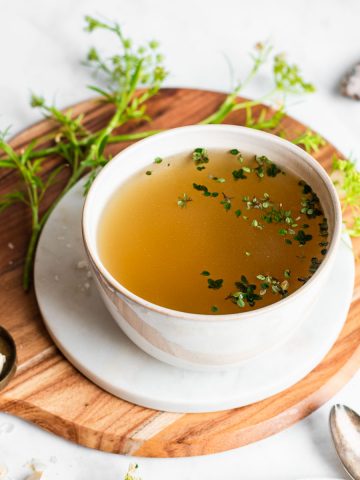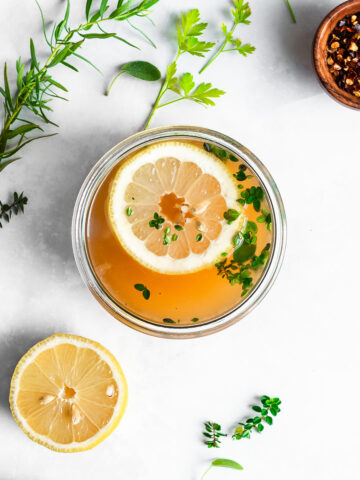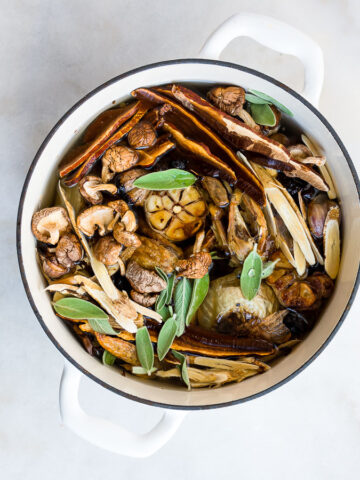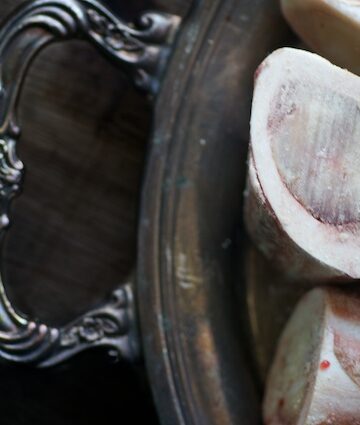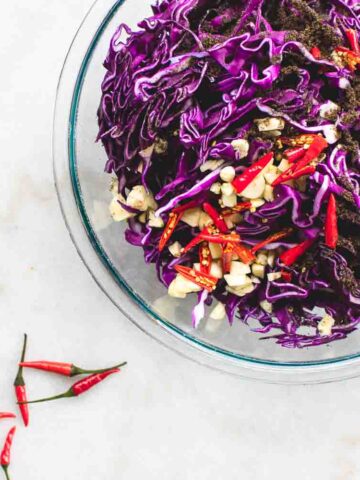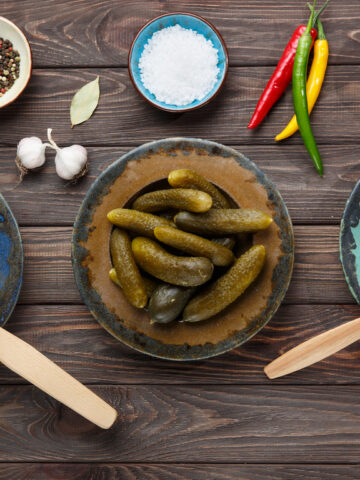Gelatinous bone broth that jiggles and bounces when cooled is a sure sign of well-made broth. It indicates that the broth contains plenty of protein. In addition, gelatinous broth has a silky texture that makes your homemade soups absolutely luxurious.
But there’s a trick to making it right. And if you’ve tried batch after batch of homemade broth and are left wondering why it won’t gel, here’s what you need to know.
Jump to Why Does it Gel? | Ingredients | Ratios | Timing | Temperature | Fixes | Common Questions
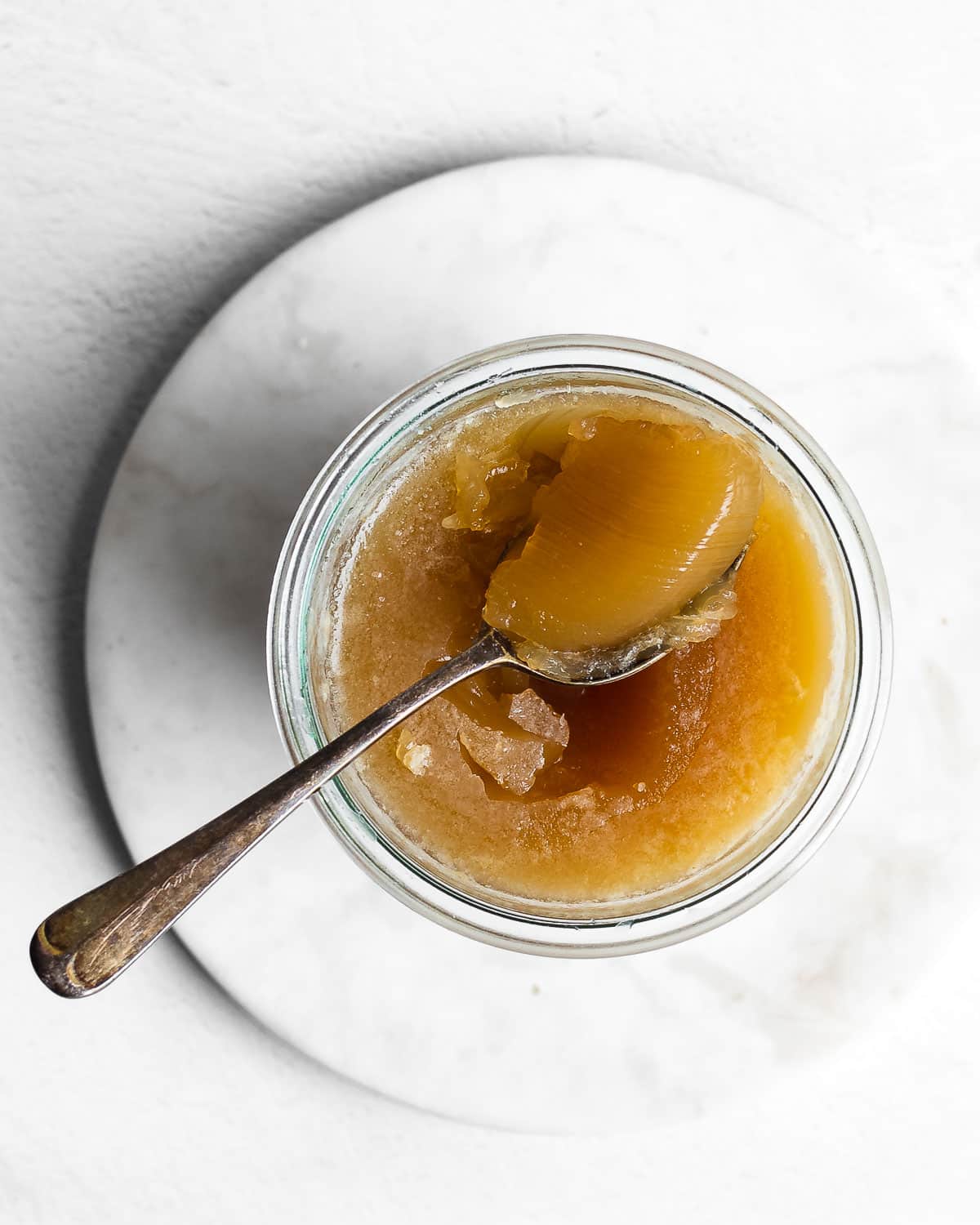
Why does bone broth gel?
The bones you use for homemade broth are rich in connective tissue. Collagen is the primary protein in connective tissue. It is a good source of various amino acids, especially glycine and proline, which support gut health.
When you simmer these collagen-rich bones in water for an extended period of time, all those amino acids in the collagen dissolve and reform to make gelatin. As a result, a well-made broth will jiggle and bounce when it cools. And that gelatin will dissolve again when you heat the broth.
It sounds simple, right? Unfortunately, there are a few factors that can mean the difference between perfect bone broth gelatin and no gel at all. You need to pay attention to ingredients, recipe, temperature, and timing.
Start with High-Quality Bones
Using a variety of bones is the key to high-quality, gelatinous bone broth. While herbs, spices, sea salt, and vegetables can give your broth flavor, the real secret is in the bones.
That’s because some cuts of meat and some bones contain more collagen than others. The more collagen-rich ingredients you add to your pot, the more gelatinous your broth will be.
What Kind of Bones to Use
- The bones from young animals tend to be richer in collagen.
- Beef knuckle bones may be large and bulky, but they’re one of the best sources of collagen and the key to good beef bone broth.
- Neck bones from pork, chicken, or beef are also a good source of collagen, and they give your broth good flavor, too.
- Chicken feet, wing tips, and backs are some of the richest sources of collagen and can be the key between a rich, gelatinous bone broth and a weak chicken stock.
- Ham hocks and trotters are loaded with connective tissue and excellent for making pork bone broth.
- Marrow bones are popular additions to bone broth, but they are a poor source of collagen and don’t make for a very gelatinous broth. So only use a small number.
Where to Find Bones for Broth
We recommend using bones from grass-fed and pasture-raised animals to make bone broth. These animals are raised outdoors on their natural diet, and their meat tends to be more nutritious than conventionally raised.
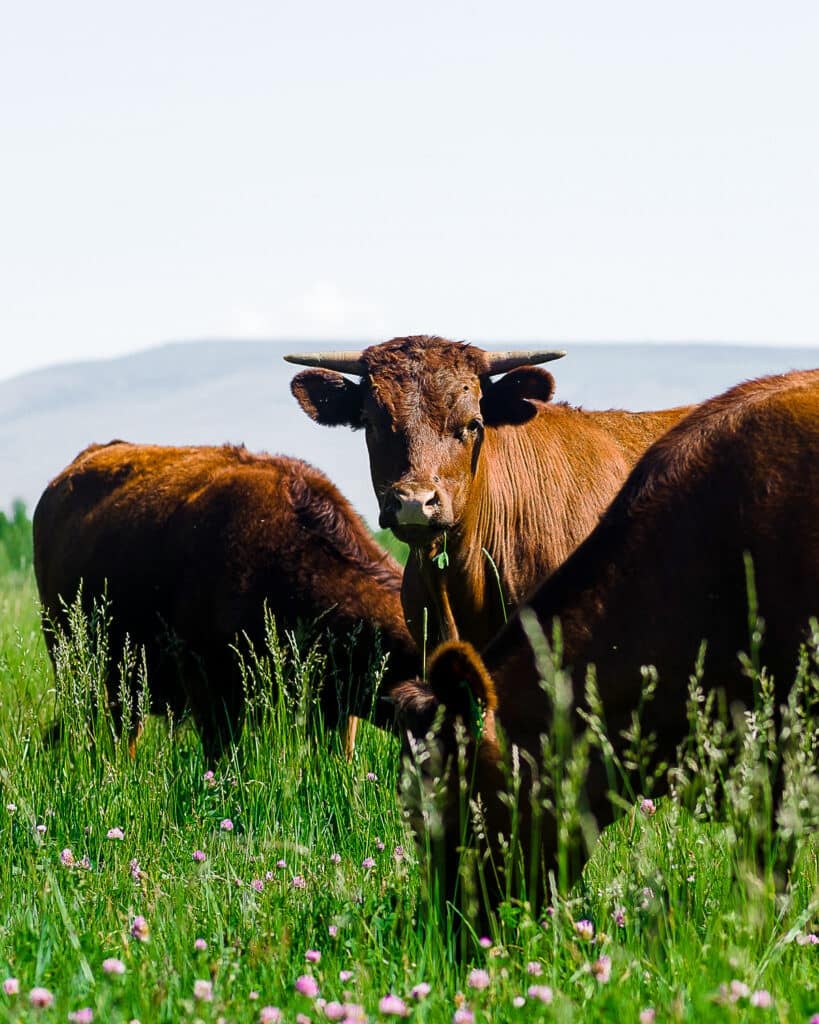
Add a Source of Acid
After you’ve selected plenty of collagen-rich bones, consider adding a little splash of something acidic. Acid helps extract the collagen in the connective tissue, resulting in a better likelihood that your bone broth gels. It’s so effective that it’s used in the commercial production of packaged gelatin.
While It’s not necessary to add acid to your homemade broth, it is helpful. And you don’t need much.
- Apple cider vinegar is the most popular choice, but it also can easily overpower the flavor of your broth, even if you only use a few tablespoons.
- Wine is the best choice because it is both acidic and it imparts an excellent flavor to your broth. Use ¼ cup to 1 cup. Both red and white wine work well.
- Lemon juice also works, and you’ll only need a tablespoon or two.
Use the Right Ratio
A good bone broth recipe will include bones and a source of acid. It may also include herbs, spices, and vegetables. These extra ingredients won’t help your broth gel, but they will give it flavor.
To make gelatinous bone broth, look for recipes that have a ratio of about 1 pound bones to 1 quart of water. This should be enough to cover the bones by about 2 inches of water. Too much water will lead to a thin broth that doesn’t gel.
Recipes should call for simmering the broth at low to medium-low temperatures for several hours. Boiling your broth rapidly for an extended period of time can deteriorate the gelatin, resulting in a broth that won’t gel.
How to Get the Timing Right
Timing affects the quality of your broth. The amount of time your broth needs depends on both the equipment you’re using and the kind of bones you’re using.
Thin, small bones, such as chicken bones, will take less time than large beef bones, which require more time to extract the collagen. Simmering broth for too long will break down the gelatin.
What kind of equipment should I use?
You can make gelatinous bone broth on the stove, in a pressure cooker, or in a slow cooker. However, cooking time varies from method to method. The easiest way to make broth that consistently gels is to use a pressure cooker, such as an Instant Pot.
- Use an Instant Pot for consistently gelatinous broth. One 90-minute cycle is usually sufficient for chicken bones.
- A slow cooker also works. It will take about 12 hours for chicken bone broth and upwards of 18 for beef bone broth.
- A large stock pot on the stove top works fine, too. Kept at a slow simmer, your broth will come together in about 6 to 18 hours, with chicken bones taking the least amount of time and large beef bones taking the most.
Mind Your Temperature
When you’re cooking your broth in a slow cooker or Instant Pot, the equipment controls the temperature for you. If you’re cooking broth on the stovetop, you’ll need to pay close attention to the temperature.
- Bring your ingredients to a rolling boil, and then immediately reduce to a light simmer.
- Gelatin will break down when held over the boiling point (212 F) for an extended period of time, so boiling your broth for hours (or days!) is a bad idea.
- Boiling too long or too vigorously may break down the gelatin while also producing a cloudy broth.
How to Fix a Broth that Doesn’t Gel
If you’ve done your best to make a gelatinous broth, and it still just won’t gel, there are a few rescues that you can try.
- Add supplementary gelatin to your broth. Some of the best bone broth brands add supplementary gelatin to their products.
- For every 3 cups of broth, you’ll need 1 tablespoon of gelatin for a loose gel similar to what you’d find in a well-made broth.
- Bloom your gelatin by placing it in a bowl. Add 2 tablespoons warm broth to every 1 tablespoon gelatin in the bowl.
- When fully hydrated, stir it into your hot broth until fully dissolved. Then turn off the heat and transfer it to the fridge.
Get the Book
Our best-selling cookbook, Broth & Stock, guides you through making a dozen master recipes (for everything from bone broth to seafood stock) with guidance on how to use them to make amazing soups, stews, risottos, and more. It's everything you need to know about nourishing broths.

Common Questions
Why is my bone broth gelatinous?
Bone broth is supposed to be gelatinous. It’s an indication that you made it correctly. Bone broth gels because it is made from collagen-rich connective tissue and bones. When simmered, the collagen transforms to gelatin and your bone broth becomes gelatinous.
Why didn’t my bone broth gel?
Your bone broth might not gel if your temperature was too high (or too low), you used too much water, you used the wrong kind of bones, or you cooked it for too long.
Do I need to use bones from grass-fed animals?
No. But we strongly encourage you to do so. Regenerative agricultural practices, such as raising animals on pasture, produce better-quality meat with a higher nutritional content. It is also better for the local environment and helps to support improved animal welfare practices.
Is my bone broth still healthy if it didn’t gel?
Yes. It’s still safe to eat, although it may (but not always) contain less protein.
What can I do with broth that didn’t gel?
You can use it in these easy soup recipes or use it as a substitute for water when making rice or beans. Alternatively, you can also use it as a substitute for water when making your next batch of broth.


